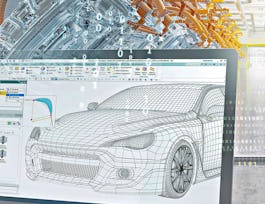The instructors of the online course "Digitalisation in Aeronautics" present a spectrum of different aviation research and application areas, exploring the impact of digitalisation in this specific field, including the effects of digitalisation in simulating the interaction of aircraft components, in overall aircraft development and related decision-making and in the communication channels used within aircraft. A broad and varied range of applications and digital solutions are explored in detail in the individual modules of this course.



Digitalisation in Aeronautics
This course is part of Digitalisation in Aeronautics and Space Specialization


Instructors: Klaus Drechsler
Sponsored by Syrian Youth Assembly
8,503 already enrolled
(180 reviews)
Recommended experience
What you'll learn
You will learn about a wide variety of digital applications utilised in aviation research.
You will understand the nearly ubiquitous presence of digitalisation in aviation research today.
You will recognise the increasing complexity across all systems, resulting in part from digitalisation.
Skills you'll gain
- Mechanics
- Engineering Software
- Software Development
- Simulation and Simulation Software
- Network Engineering
- Engineering Design Process
- Computer Science
- Engineering Practices
- Computer Networking
- Digital Communications
- Dimensionality Reduction
- Vibrations
- Data Analysis
- Network Architecture
- Network Administration
- Model Based Systems Engineering
- Network Infrastructure
- Mechanical Engineering
- General Networking
- Engineering
Details to know

Add to your LinkedIn profile
4 assignments
See how employees at top companies are mastering in-demand skills

Build your subject-matter expertise
- Learn new concepts from industry experts
- Gain a foundational understanding of a subject or tool
- Develop job-relevant skills with hands-on projects
- Earn a shareable career certificate


Earn a career certificate
Add this credential to your LinkedIn profile, resume, or CV
Share it on social media and in your performance review

There are 5 modules in this course
Bavarian State Minister of Digital Affairs Judith Gerlach provides a brief introduction to the digital strategy of the state of Bavaria, describing the importance of digitalisation in global manufacturing and research and the aerospace industry in particular. She demonstrates compellingly how an effective strategy can be devised for staying on top of the developments in this complex field of research.
What's included
3 videos
The online course unit Collaborative Aircraft Design provides an introduction to the aircraft design process. It provides an overview of specifics in the design process, focusing particularly on challenges in early production phases. The course unit explains how aircraft design modelling decisions are made, illustrates usage of the TUM ADEBO design tool box and looks at worksharing processes in aircraft development. - Lecturer: Professor Mirko Hornung (Technical University Munich & Bauhaus Luftfahrt).
What's included
3 videos1 reading1 peer review
The growing complexity of avionics systems and the associated high number of point-to-point data connections have led to the introduction of digital networks in aerospace. These serve to interconnect the system components installed in aircraft/spacecraft and integrate subsystems into a higher-level system, enabling efficient on-board communication. Because of their key role such networks are subject to special requirements. In addition to bandwidth failure resilience and interference are therefore of major importance. The lecture addresses general requirements, topologies and signal transmission types and explains bus systems currently in use such as ARINC429, Mil-Std-1553 and AFDX. - Lecturer: Dr.-Ing. Peter Stütz (Universität der Bundeswehr München).
What's included
4 videos4 assignments
Aircraft systems embrace a large set of physical domains. Hydraulic, pneumatic and electrical systems all act within a confined space under extreme environmental conditions. Global optimisation of an aircraft including all of its systems thus demands a harmonised modelling approach so that all systems can be simulated and evaluated on a common platform. Modelica offers an open and free standard for multi-domain modelling of physical systems. Individual components are modelled using differential-algebraic equations while large complex systems can be composed using object-oriented methods. The underlying principles of such modelling languages are explained in this lecture and how they can be applied for aircraft systems. The resulting multi-domain models afford digital representations of aircraft systems which can then be used to optimise aircraft design. Modern energy management methods can improve system performance, while model-based fault analysis methods help ensure safety and reliability. - Lecturer: Dr. Dirk Zimmer (DLR German Aerospace Center).
What's included
4 videos1 reading1 discussion prompt
Digital models for (flexible) Aerospace system behaviour are often high-order and have to be reduced when used in combination with models from complementary disciplines or where many parametric iteration steps are required, such as for design optimisation. Typical examples are control-structure interaction problems, such as vibration attenuation of satellite solar arrays and aero-elasticity and dynamic load alleviation of aircraft. In this module methods are discussed for realising a reduced order model (ROM) from a higher order model. To avoid multiple repetitions of often-costly reduction processes in cases where model parameters are varied, e.g. for system optimization, model parameters should be set for these ROMs to yield so-called P-ROMs. The effect of varied parameters can then be covered on the level of the previously established ROM simply by updating these via the new relevant parameters. The related methods are also called ‘hard computing’ methods because of the mathematically based approach, requiring a relatively well-structured set of the initial full-order systems of equations. These methods can be applied to a multitude of aerospace problems such as vibration control for satellites in orbit and dynamic aero-elastic load alleviation for aircraft. Possibilities for reducing computational effort when using P-ROMS, such as for design optimisation tasks for space structures, are also discussed. - Lecturer: Professor Horst Baier (Technical University Munich).
What's included
9 videos2 readings1 discussion prompt
Instructors


Offered by
Why people choose Coursera for their career




Learner reviews
180 reviews
- 5 stars
76.11%
- 4 stars
16.66%
- 3 stars
4.44%
- 2 stars
2.22%
- 1 star
0.55%
Showing 3 of 180
Reviewed on Aug 5, 2021
An interesting and concise course ! I thank very much all the members of the team
Reviewed on Jan 16, 2022
The course helped me to improve my knowledge; of all areas of the cabin of an Airplane cockpit.
Reviewed on Jan 5, 2021
It is the first-ever course I take but to say that I was impressed is the least. The material, the information delivery, and the course overall are really amazing.
Recommended if you're interested in Physical Science and Engineering

University at Buffalo

London Business School

University at Buffalo

University of Geneva

Open new doors with Coursera Plus
Unlimited access to 10,000+ world-class courses, hands-on projects, and job-ready certificate programs - all included in your subscription
Advance your career with an online degree
Earn a degree from world-class universities - 100% online
Join over 3,400 global companies that choose Coursera for Business
Upskill your employees to excel in the digital economy


